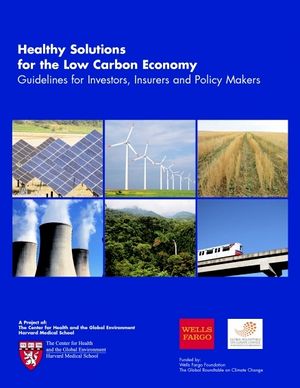Healthy Solutions for the Low Carbon Economy: Introduction
| Topics: |
Contents
Introduction
As the pace of climate change (Healthy Solutions for the Low Carbon Economy: Introduction) quickens, the world is suddenly faced with food, fuel and financial crises. Systemic measures, beginning with a comprehensive change in energy systems, will be needed to address the underlying drivers.
In the coming decades, world energy use will rise as oil supplies peak and ultimately decline. In 2005, the world used energy at a rate of 16.3 trillion watts (terawatts or TW). A watt is a rate equal to one unit of energy (a joule) per second (J. Holdren, pers. comm. 2008). By 2050, energy demands are projected to double (EIA 2005). These estimates do not include increased demands due to water stress and prolonged heat waves.
Oil is the primary source of energy: the world consumes 86 million barrels daily or 40,000 gallons a second (EIA 2007).
To meet growing needs, the petroleum (Petroleum refining) industry estimates that $20 trillion will be invested in new energy infrastructure over the next 25 years (IEA 2007).
Meanwhile, 89,000 TW of sunlight reach Earth’s surface and utilizing 600 TW is a practical target. Additionally, 50 TW of wind energy are available on land and 3 TW are practically available (Lewis 2004).
This report explores avenues, as well as financial and policy instruments, for redirecting investments into a renewable, reliable and robust energy infrastructure-- a prerequisite for coping with climate change, controlling fuel and food prices, sustaining healthy economies, and stabilizing the climate.
Climate Change and Health, Energy, Transport and Water
Climate change threatens human health and well-being, natural and managed ecosystems, economies and global political stability (Epstein and Mills 2005; IPCC 2007b; CNA 2007). Climate change also threatens the energy sector.
Storms can: 1. Disrupt oil rigs, pipelines and refineries (25% of Gulf of Mexico oil and gas production is still down three years following Katrina); and 2. Interrupt transmission (as did a massive snowstorm in China in Jan/Feb 2008). Heat waves can 3. Cause power outages (e.g., almost half the U.S. lost power in the summer of 2003); and 4. Shut down nuclear power plants (as occurred in France, summer of 2003). Meanwhile, 5. Thawing tundra is undermining arctic pipelines; and 6. Shrinking montane glaciers threaten hydropower in developed and developing nations.
Prolonged U.S. Southwest drought is affecting the cooling water for over 24 of the nation’s 104 nuclear energy reactors (Hightower 2008).
Climate change threatens the transport sector, posing new challenges for planning, design, construction, operation and maintenance of infrastructure. Today’s decisions regarding retrofitting of existing -- and placement of new transportation -- infrastructure will affect how well the systems adapt to a changing climate far into the future.
With freshwater aquifers overdrawn and underfed in many regions, water supplies will be further compromised by disappearing montane glaciers and dwindling snowpack (Barnett et al. 2008). Today, 1.7 billon people live in “water-stressed” nations and the number may reach 5 billion by 2025 (IPCC 2007a).

Meanwhile, lack of energy or energy poverty hinders development. Developing economies need consistent energy supplies to power their development and cope with more volatile weather. Where utility grids are inadequate, stand-alone power generators -- using solar, wind, human and bicycle-assisted power -- can be used to pump, decontaminate and desalinate water, irrigate land, power clinics, light homes and run small businesses. Clean, distributed energy is necessary for meeting the Millennium Development Goals (Wilkinson et al. 2007; Haines et al. 2007).
“Electricity cuts plague 35 nations [and] outages are stifling a boom in Africa,” warned the Wall Street Journal this spring (Childress 2008).
The Stabilization Wedges
A set of energy solutions, called the “stabilization wedges,” was developed by Steve Pacala and Robert Socolow of Princeton University (2004), and provides a template for developing comprehensive energy plans. Fifteen energy choices were depicted and several others have since been proposed. Each wedge would avoid 1 billion tons (a gigaton or Gt) of carbon emissions annually by mid-century, by reducing CO2and CO2-equivalent (CO2-e) emissions.
A caveat: By 2004 calculations, seven wedges would offset projected increases in emissions by 2054. But stabilizing or reducing concentrations of GHGs will require increasing the number of wedges implemented or doubling the size of each wedge, or both.
Analyses of the wedges, to date, focus on technological and economic feasibilities. But some options may prove unsustainable due to serious health and environmental damages. Some may inadvertently enhance global warming. It is therefore incumbent upon us to assess the net energy gain (including water and material inputs), and explore the potential side effects of each step in the life cycle of new technologies. Meanwhile, we can identify measures with health, environmental and economic co-benefits in which we can invest, insure and enable through sound public policies.
The List of Energy Options
As Depicted by Pacala and Socolow, Science 2004; 305:968-971.
|
Efficiency 1. Double fuel economy for 2 billion cars from 30 to 60 mpg 2. Halve vehicular miles traveled for 2 billion cars: urban design, mass transit, telecommuting 3. Cut carbon emissions by one-fourth from buildings and appliances 4. Double coal-power output with advanced high-temperature materials | |
|
Fuel shift 5. Replace 1400 GW of coal-fired power with natural gas plants | |
|
6. CCS for 800 GW worth of coal or 1600 GW natural gas: average plant = 1 GW 7. Capture CO2 at plants producing H2 from coal or natural gas 8. CCS at synfuels plants producing 30 million barrels a day from coal | |
|
Nuclear fission 9. Add 700 GW: twice the current capacity | |
|
Renewable electricity and fuels 10. Add 2 million 1MW-peak windmills: 50 times current capacity 11. Wind-derived H2 for fuel-cells in hybrid cars: add 4 million 1 MW-peak windmills to make H2 or 100 times current capacity 12. Add 2000 GW-peak photovoltaics (PV): 700 times current capacity 13. Add 100 times the current ethanol: one-sixth of world cropland | |
|
Forests and agricultural soils 14. Eliminate deforestation; reforestation and afforestation: 300 Mha of new trees or twice current rate 15. Conservation tillage for all cropland: 10 times the current usage |
| This is a chapter from Healthy Solutions for the Low Carbon Economy: Guidelines for Investors, Insurers and Policy Makers (e-book). Previous: Overview and Key Points (Healthy Solutions for the Low Carbon Economy: Introduction)|Table of Contents|Next: Technologies for Early Adoption |







